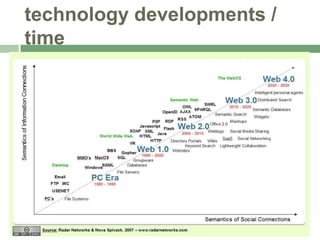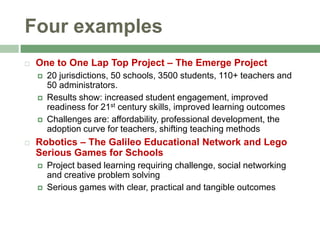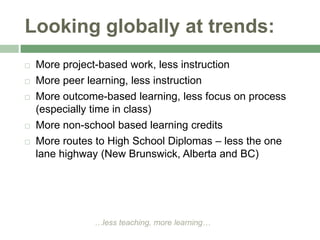Ontario november 2010 final schools
- 1. Presentation to ILC, November 2010Fast Forward for adifferent futureHow Emerging Technologies are Transforming Education and SchoolsHow To Capitalize on It Stephen Murgatroyd, PhD FBPsS FRSAChief Innovation Officer
- 2. This presentation…..Set a challenge context for this discussion….What is happening with technology?How is this having an impact on education, learning and schools?What are the “design, development and deployment” (3D) implications for schools?What are the challenges this gives rise to?
- 4. Significant changes taking placeDemographicsLow birth rates and dependency on immigrationFast growth of aboriginal communitiesLiteracy EconomicsLow productivityDeclining competitivenessMajor industry sector transitions – manufacturing, forestry, agricultureSocio-economic disruptionSocial ChangeNew forms of social meaning and networksNew globalized relationships – “glocal”New challenges for the curriculum – 21st Century Skills
- 5. Shifts in K-12 EducationFocus on 21st Century SkillsBuilding on skills base of current curriculum, but a significant shiftMore project work, less “instruction” – constructivist learningCommitment to essential skills – literacy, numeracy and technological literacyStrong focus on “personalization”Seeking to increase student engagement through enabling more choiceMatching personal intentions / skills to curriculum optionsAccountabilityHolding schools and school districts accountable for performanceLinking resource allocation to performanceFocusing on core skills for accountability – especially literacy and numeracyBig focus on student engagementLower funding with higher outcome expectationsClass size, funding for special needs students and FNMI “tight”Resource base (funds for infrastructure, materials and technology) also tightGrowing expectations of more throughput to post-secondary
- 6. 21st Century Skills FrameworkSource: Meteri Group and the North Central Regional Educational Laboratory (USA)
- 7. Demand for skills over time(OECD data base)
- 8. In OntarioClear commitment to education from the Premier downFocus on system wide accountability and performance and system wide development – Ben Levin and Michael Fullan’s interventionsSeeking to expand affordable access to post-secondary, especially for first nations and first generation learners – puts pressure on schools to produce more qualified studentsSeeking to have a major impact on essential skillsSeeking to embrace technology in the classroom
- 9. Emerging technologiesThe emerging technologies that are changing the way we work and play
- 10. The emerging technologiesLow cost (relative to capacity) hand held digital devices – the iPad, smartphone, PlayBook (RIM), Livescribe, GPS….Broadband access at a low cost – free Wi-Fi, cellular bandwidth (4G), new ways to access broadbandIncreasing graphical capacity and speed of digital devices – e.g. Smart BoardsDevelopments in artificial intelligence and machine learningDevelopments in robotics, miniaturizing of components and in visual capacities of digital devices3D television and the imminent arrival of 3D video conferencing
- 11. And technological applicationsThe development of 250,000+ apps growing at (approximately) 2,000 a dayThe emergence of social media – Facebook, LinkedIn, Twitter, YouTubeThe rapid adoption of co-creation systems – Wilki’s and related collaborative software (now integrated into Adobe, Office, etc.), NingSophisticated gaming engines and animation – permitting simulationSemantic web – intelligent agents, searching using machine learning
- 12. And technological “solutions”Cloud-based computingIntegrated software - permitting easy movement of data, images etc., from one place to another for fast creationIntegrated resource management – e.g. Alibris, eBayFile sharing (Dropbox) and file “stealing” (Pirate Bay)Focused document management (e.g. ancestry.ca)Flash video and easy editing toolsDigital photography and digital video
- 13. technology developments / time
- 14. How we can leverage emerging technologies to improve learning outcomes in K-12Leveraging Technology for Learning
- 15. #1 Blended LearningDesigned learning experience which:Use online for knowledge and in class for experiential workEngage students in learning through projects and activity- based problem-solvingLeverage social networksUse web based resources via Smart Boards and digital devices to support classroom learning#2 SimulationLeveraging digital devices (especially emerging 3D capacities) for:Simulating experiments in scienceSimulating tasks – e.g. robotics Simulating environmental conditions (e.g. virtual wetlands)Leveraging the power of artificial intelligence / machine learning to use simulations as a competency-based diagnostic toolClassroom Based Teaching
- 16. #4 Cloud-Based LearningIn an outcome-based program where credit is awarded following a demonstration of outcome competences:Learners use social networks, peer networks and expert clouds to secure their learningLearners access knowledge through digital resource librariesTeaching is minimal, the focus is on competency#3 One to One Lap Top ProjectsLeveraging the power of technology to enable a learner to:Work in different ways and use different styles of learning Engage with social networks in support of learningDevelop 21st century skillsDevelop critical thinking and analytic skillsFocus in classroom on processing knowledge / developing understanding
- 17. #5 Digital Textbooks and Libraries#6 RemediationUsing the powers of machine learning, robotics and mobility to provide learners with:Patient remedial learning for skills and knowledge they find problematicUsing global teaching networks to provide 24x7 coaching helpUsing peer networks and social networks for remediationLeveraging the power of technology and coopetition to:Developing glocal texts (standard texts with local components) for glocal coursesUsing the publishing consortia to accelerate the arrival of new knowledge into textsUsing online libraries and resource centres for text, audio, video and other resources..
- 18. #8 Wicked Problem-Based Learning #7 Location Supported LearningUsing teams of learners, supported by an teacher and / or mentor, to tackle problems that matter (e.g. water, literacy, financial literacy):Connecting to “non” academic solutions organizationsLeveraging peer networks and social networks – using the cloudSerious research and serious gamesCommunity-based assessment – impacts, competencies and outcomesLinking learning activities to location enablesA variety of curriculum areas to be linked to place – history, social studies, geography, science..Supports real time biodiversity information being integrated into projects and coursesLeverages global knowledge bases around species and environmental genomicsProvides rich access to local expertise
- 19. #9 Just in Time Learning#10 Support for Students with Special NeedsModularised curriculum linked to support for:Work-based skills – e.g. trades education in school as part of the dual curriculumEssential skills and financial literacyUpdating knowledge and skills – the next building code skills, next bio-refining process, the next robotic maintenance process….Using technology to:Enhance learning opportunities and learning experiences of learners with special needsEnhance hearing and visual abilitiesEnhance motor skillsEnable learner support
- 20. Innovation in actionFour examples of emerging technologies used in education and training
- 21. Four examplesOne to One Lap Top Project – The Emerge Project20 jurisdictions, 50 schools, 3500 students, 110+ teachers and 50 administrators. Results show: increased student engagement, improved readiness for 21st century skills, improved learning outcomesChallenges are: affordability, professional development, the adoption curve for teachers, shifting teaching methodsRobotics – The Galileo Educational Network and Lego Serious Games for SchoolsProject based learning requiring challenge, social networking and creative problem solvingSerious games with clear, practical and tangible outcomes
- 22. Literacy and Essential SkillsWorking with reluctant readers using reading games and reading challenges onlineWord skill development using “build a word” linked to sound and visualizationDedicated literacy softwareCapturing Aboriginal Knowledge and Content CreationUsing video, audio and blogs to capture aboriginal knowledge – e.g. healing properties of plants, “about this place”, our band…Using elders to support students in learning Cree
- 23. Looking globally at trends:More project-based work, less instructionMore peer learning, less instructionMore outcome-based learning, less focus on process (especially time in class)More non-school based learning credits More routes to High School Diplomas – less the one lane highway (New Brunswick, Alberta and BC)…less teaching, more learning…
- 24. What we can say…Technology supports student achievementTechnology builds 21st century skillsTechnology engages students in learning and content creationTechnology increases educational access to virtual communities and distant expertiseTechnology fosters inclusionTechnology helps reduce dropoutTechnology facilitates differentiated instructionTechnology strengthens career and technical educationTechnology extends the learning dayTechnology supports teacher qualityTechnology supports timely, innovative and diagnostic assessmentTechnology enables innovation and creativity by both students and teachers
- 26. System wideCost of technology and greening the technology infrastructure seen as problematicEquity of access to technology (especially broadband) seen as a challengeEquity of access to professional development to support technology implementation in the classroom seen as problematicNot a strong focus on technology in initial teacher educationAdoption slow amongst the teaching body
- 27. In one Province, the technology adoption level by teachers is app. 40-50% - teachers using technology frequently and in an integrated way in their teaching.
- 28. At the school levelTeahersTeacher adoption levels “stuck” at early stage – 40-50% of facultyTeachers defense of “classroom teaching” versus technology Scale of curriculum demands inhibits innovationDesign CapacitiesInstructional design capacities low and creation capacities low amongst teacchersTransformative capacity of technology not being fully realizedStudentsNot all want to be engaged learners – many are tactically engaged or compliantNot all have access at homeNot all are technological literateStrategic IntentCommitment to technology is “and also..” commitment
- 30. The New school….Will have more individual work spaces and some rooms for team workWill have wicked problem based courses and programsWill have a requirement for peer, social and networked learningWill have fewer limitations on securing non-school taught creditWill focus on outcomes, not timeWill be wired to firms, community and non profitsWill have very high levels of student engagement and few tactical compliant learnersWill have very satisfied teachers who coach, guide and mentor and support learning as well as provide instruction – more constructivist learningWill be truly learning focusedWill be nimble and innovativeFor an example of such a school, see the RSA Academy at Tipton (UK) http://www.rsaacademy.net/































